Current Optics and Photonics
Vol. 2, No. 4, August 2018, pp. 315-323
ISSN: 2508-7266(Print) / ISSN: 2508-7274(Online)
DOI: https://doi.org/10.3807/COPP.2018.2.4.315
Research on Multiple-image Encryption Scheme Based on
Fourier Transform and Ghost Imaging Algorithm
Zhang Leihong1, Yuan Xiao1
*, Zhang Dawei1, and Chen Jian2
1University of Shanghai for Science and Technology, Shanghai 200093, China
2Anhui Province Key Laboratory of Nondestructive Evaluation, Hefei 230031,China
(Received April 26, 2018 : revised July 4, 2018 : accepted July 11, 2018)
A new multiple-image encryption scheme that is based on a compressive ghost imaging concept along
with a Fourier transform sampling principle has been proposed. This further improves the security of
the scheme. The scheme adopts a Fourier transform to sample the original multiple-image information
respectively, utilizing the centrosymmetric conjugation property of the spatial spectrum of the images to
obtain each Fourier coefficient in the most abundant spatial frequency band. Based on this sampling
principle, the multiple images to be encrypted are grouped into a combined image, and then the compressive
ghost imaging algorithm is used to improve the security, which reduces the amount of information
transmission and improves the information transmission rate. Due to the presence of the compressive
sensing algorithm, the scheme improves the accuracy of image reconstruction.
Keywords : Fourier transform, Compressive sensing, Ghost imaging, Multiple-image Encryption
OCIS codes : (070.2575) Fractional Fourier transforms; (100.3010) Image reconstruction techniques;
(200.4560) Optical data processing
I. INTRODUCTION
information
With the rapid development of computer and Internet
technologies, information security has attracted more and
more researchers. Due to the ultra-high speed and multiple
dimensional processing, optical
security
technology has been popular for a long time, including
double random phase encryption technology [1-5] and ghost
imaging technology [6-10]. As another important branch of
optical encryption, multiple-image encryption technology
has attracted more and more attention because it not only
improves the encryption ability but also reduces the data
volume of the ciphertext. As far as multi-image encryption
technology is concerned, it mainly focuses on researching
new methods for simultaneous encryption of multiple images,
to enhance the security of data and improve the robustness
of the system.
Klyshko proposed a ghost imaging scheme that has
attracted more and more attention owing to its remarkable
physical properties [6]. Katz et al. achieved computational
ghost imaging based on a compressive sensing algorithm
instead of the intensity correlation operation, which greatly
reduces the number of measurements; when the signals
and images are sparse or can be sparse in some transform
domains, the use of a compressive sensing algorithm can
directly measure and simultaneously compress the signal or
image. Finally, the signal will be reconstructed by the
receiver’s reconstruction algorithm [11-13].
In order to improve coding efficiency, the methods of
multiple-image encryption based on position multiplexing
and computational ghost imaging [14]; double random phase
encryption [15] etc. have been proposed. Lee and Cho [15]
proposed a multiple-image transmission method based on
double random phase encryption using orthogonal encoding,
which uses two random phase masks and orthogonal
encoding. The orthogonal encoding for multiple images
uses a larger Hadamard matrix than that for a single image,
increasing the security of encryption. Li et al. [16] proposed
*Corresponding author: yxhello365@163.com, ORCID 0000-0002-2878-3217.
Color versions of one or more of the figures in this paper are available online.
*
This is an Open Access article distributed under the terms of the Creative Commons Attribution Non-Commercial License (http://creativecommons.org/
licenses/by-nc/4.0/) which permits unrestricted non-commercial use, distribution, and reproduction in any medium, provided the original work is
properly cited.
*Copyright
2018 Current Optics and Photonics
- 315 -
�
316
Current Optics and Photonics, Vol. 2, No. 4, August 2018
a multiple-image encryption method based on compressive
ghost imaging, in which an improved logistic mapping
algorithm and the coordination of sampling were used to
achieve multiple-image encryption and decryption; Wu et
al. [17] proposed a multiple-image encryption scheme
based on computational ghost
imaging with different
diffraction distances, each plane image is encrypted into an
intensity vector, and then all the intensity vectors are
added together to generate the final density in order to
improve the effectiveness and security of the multiple-image
encryption scheme; Yuan et al. [18] proposed a multi-image
encryption scheme with a single-pixel detector according
to the principle of ghost imaging. In this scheme, all the
emitted light is recorded by a single-pixel barrel detector
to obtain ciphertext, and any secret
images can be
independently decrypted from the ciphertext. The above
encryption methods are provided with good security, but in
computational ghost imaging, thousands of calculations are
needed to obtain acceptable results. In some applications, a
large amount of storage space is required for optical image
encryption based on ghost imaging. In this sense, we
propose a multi-image encryption scheme based on Fourier
transforms and compressive ghost imaging. The images
adopt Fourier transforms to obtain the image information.
According to different sampling rates, multiple images are
synthesized into an image in the Fourier space. Then the
encryption and decryption was achived by the compressive
ghost imaging algorithm, which realizes data compression
and reduces the storage space of the data. Firstly, the
theoretical analysis and description of the method are given,
and then simulation verification is carried out. Finally, the
conclusion is drawn.
II. THEORETICAL ANALYSIS
2.1. Optical Encryption Mechanism Based on Compressive
Ghost Imaging Algorithm
In the computational ghost imaging encryption system,
the spatial light modulator (SLM) that inputs a series of
phase masks is used, as shown in Fig. 1 [19]. The plane
wave is modulated by the phase masks and a Fresnel
diffraction occurrs with a distance Z from phase masks
plane to object plane. Then the light intensity distribution
in the object plane could be calculated by using the
Fresnel diffraction, which can be expressed as [20]
yxI
,(
i
)
=
FrTz
{
exp[
j
2
πϕ
i
,(
yx
} 2
)]
(1)
{ }
FrT
,(
where
)
yxϕ
represents the Fresnel diffraction transform,
is the pixel distribution of each phase mask, whose
pixel values are randomly from 0 to 1. The subscript “i”
represents the i-th measurement value using the i-th phase
mask, and the subscript “Z” represents diffraction distance,
and the amplitude of the plane wave is defined as unit one.
FIG. 1. Schematic of computional ghost image encryption
system.
Therefore, the new imaging process only requires a bucket
B , which can be
detector (BD) to obtain the ciphertext
expressed as
i
B
i
,(∫=
yxIyxT
,(
)
i
)
dxdy
(2)
yxT
,(
)
where the
is the image to be encrypted. Therefore,
the image T to be encrypted is successfully encoded in a
series of light intensity ciphertext data
B using the phase
mask key and the distance parameter Z. During the
decryption process, an intensity-related operation occurred
between the intensity distribution
and intensity
ciphertext data
B from the bucket detector to calculate a
secret image, which can be expressed as
,(
yxI
)
i
i
yxG
,(
)
〈=
yxIB
,(
)
〈−〉
yxIB
,(
〉〈
i
i
i
i
)
〉
(3)
where 〈•〉 represents the average operation.
However, the ghost imaging algorithm is a statistical
feature extraction process. The detection time required for
imaging and the resolution time for the reconstruction
algorithm are relatively long. In order to solve this problem,
Donoho proposed a new reconstruction algorithm based on
compressive sensing, which greatly reduced the number of
exposure samplings and reduced the amount of computation.
At the same time, more encrypted information can be
transmitted and the amount of information transmitted is
increased under the same calculation conditions. That is to
say, the ghost imaging combined with the compressive
sensing algorithm successfully solves the problems of long
imaging time and low accuracy of object reconstruction.
The specific encryption process is: the plaintext image
to be encrypted is a two-dimensional image, and
the size is × which is stretched into a column vector
( × ). For the m-th measurement, the light distribution
)
function of the reference arm at the pixel point
is
, whose matrix
,
expression is:
2,1=
2,1
, =
qp
(
x ,
m
,
N
y
x
n
)
(
y
I
p
q
p
q
,
m
=
I
m
⎡
⎢
⎢
⎢
⎢
⎢
⎣
I
m
11
I
m
21
I
m
1
n
I
m
2
n
I
m
1
n
I
m
nn
⎤
⎥
⎥
⎥
⎥
⎥
⎦
(4)
�
Research on Multiple-image Encryption Scheme Based on … - Zhang Leihong et al.
317
The matrix size is × ,
is the intensity of the light
measured by the m-th measurement at the pixel point
() of the CCD measurement plane, which is stretched
into a one-dimensional row vector. After N times of
measurement, the N × one-dimensional row vectors
recorded by the CCD are stored in columns to get a
, the size of which is × and as
random matrix
a measurement matrix of compressive sensing, ie
The matrix of the sampling image is represented in
Eq. (9), where (x,y) denotes a two-dimensional matrix in
the spatial domain and (u,v) denotes a two-dimensional
matrix in the Fourier domain. The value of i varies
from 1 to k, where k is the total number of images to
be encrypted, the images are sampled by a sampling
operation to obtain useful information in the images;
),(
vus
i
Ω=
i
),(
yxfFvu
,(
[
i
])
(9)
⋯
⋯
The expression of the encryption process is:
⋮
⋯
⋯
⋯
⋯
⋮ ⋱ ⋮ ⋱ ⋮
⋯
⋯
⋮
⋮
(5)
(6)
(a)
(b)
(c)
(d)
A compressive sensing algorithm is used for decryption.
The original signal can be reconstructed from these projections
with high probability by solving an optimization problem.
The minimum norm convex programming problem is
shown in Eq. (7). The CS reconstruction algorithm recovers
the signal as in Eq. (8).
min∥∥ st
′argmin∥ ′ ∥
(7)
(8)
2.2. Fourier Transform Encryption/ Sampling Principle
The two-dimensional image Fourier transform is to
convert the distribution of image luminance values in the
spatial domain to the frequency domain distribution of the
image. In this paper, the fast Fourier transform (FFT) can
be used to convert the image signal from the spatial
domain to the frequency domain for analysis. Using the
sparseness and conjugacy of the spatial spectrum of the
image, the important information of the image is obtained
according to different sampling rates in the Fourier space.
In this paper, four binary images are taken as an example.
The spectrum and sampling are shown in Figs. 2 and 3.
2.3. The Method of Multiple-Image Encryption
The multiple-image encryption and decryption process
based on the Fourier transform and compressive ghost
imaging algorithm are shown in Figs. 4 and 5. The main
steps are as follows:
(1) Fourier transforms are applied to the multiple images
and converted from spatial domain to frequency domain;
(2) In the frequency domain, multiple images are sampled
and combined to form a single ciphertext, and the
formed single ciphertext is used as the plaintext image
of the next encryption algorithm with ghost imaging.
(e)
(f)
(g)
(h)
FIG. 2. (a-d) are four original images; (e-h) are their corres-
ponding spectrograms.
(a)
(b)
(c)
(d)
(e)
FIG. 3. (a-e) are spatial spectra with sampling rates of 6%,
11%, 25%, 50%, and 75%.
FIG. 4. Multiple-Image encryption schematic based on Fourier
transform and Compressive sensing ghost imaging algorithm.
�
318
Current Optics and Photonics, Vol. 2, No. 4, August 2018
(a)
(b)
(c)
(d)
(e)
(f)
(g)
(h)
(i)
(j)
(k)
(l)
(m)
(n)
FIG. 6. (a-d) are the original images; (e-h) are the corres-
ponding spectrograms; (i) is the combined image with a
sampling rate rate of 50%; (j) is the combined ciphertext (The
real part and the imaginary part are respectively subjected to
ghost imaging and then recombined into a plural form); (k-n)
are different reconstruction images.
3.1. Feasibility Analysis
the optical
information encryption method
Feasibility refers to the situation where the recipient
recovers the original graphic information by using the key
shared by the sender and the ciphertext delivered on the
common channel. The feasibility assessment is performed
using
to
reconstruct the resolution of the plaintext information,
which is measured using subjective judgments and objective
parameters. In this section we will discuss the feasibility of
the encryption method, and compare the Fourier transform
and compressive ghost imaging (FFT-CGI) with the Fourier
transform and ghost imaging algorithm (FFT-GI). As shown
in Figs. 7 and 8.
In order to objectively and accurately evaluate the quality
of the recovered images using the encryption method. The
commonly used objective evaluation indicators include
mean square error (MSE) and peak signal-to-noise ratio
(PSNR). The basic idea is to measure the degree of
deviation of the pixels of the reconstructed image from the
corresponding pixels of the original image to evaluate the
quality of the reconstructed image. For a size of M × N
image, the mathematical expression for MSE and PSNR is:
FIG. 5. Multiple-image decryption schematic based Fourier
transform and compressive ghost imaging algorithm.
(3) Since the formed single ciphertext is of the character-
istics of a complex-valued function, it is separated into
real and imaginary parts. Then, they are transmitted
and encrypted by using ghost imaging. With a random
modulation signal as the key, encryption can be achieved
due to the randomness of the key;
(4) The compressive sensing algorithm is used to decrypt
separately the transmitted ciphertexts and combine the
decrypted parts into a plural form. Therefore, the
combined image is obtained. The combined image
contains the reconstructed multiple images through
),(
vuΩ
operation;
(5) The inverse Fourier transform is performed on the
reconstructed images to obtain the original images.
III. SIMULATION RESULTS AND ANALYSIS
In order to verify the effectiveness and feasibility of this
method, a numerical experiment was carried out for this
method. The experiment was mainly realized by MATLAB
software. The selected experimental object is four 64 × 64
binary images. The four binary images adopt are transformed,
and the transformed images are sampled according to
different sampling rates; the images obtained by Fourier
transform sampling are used as the plaintext images of the
compressive ghost imaging algorithm. That is, the object
to be imaged; Transforming a pre-fabricated light
into a row as a measurement
field intensity matrix
matrix for the compressive ghost imaging algorithm; The
measured value obtained by multiplying the pre-determined
light field intensity matrix and the binary image is taken
as the total light intensity , and the N precast light
field intensity matrices are arranged in order to form a
measurement matrix . The object to be imaged is measured
to obtain N measurement values, and the image of the
object is reconstructed by Eq. (5). The simulation results
are shown in Fig. 6.
�
Research on Multiple-image Encryption Scheme Based on … - Zhang Leihong et al.
319
′
×
lg
max
(10)
(11)
where an ′ represent respectively the pixel value of
the original image and the restored image, max represents
the value of the largest pixel in the image. The larger the
PSNR value, the more similar the two images are. That is,
the higher the recovered picture quality, the better the
encryption algorithm is.
FIG. 7. Reconstruction images of FFT-CGI (a1-d1) are the original images; (e1-h1) are the reconstructed images with the sampling
rate of 6%; (i1-l1) are the reconstructed images with the sampling rate of 11%; (m1-p1) are the reconstructed images with the sampling
rate of 25%; (q1-t1) are the reconstructed images with the sampling rate of 50%; (u1-x1) are the reconstructed images with the
sampling rate of 70%.
FIG. 8. Reconstruction images of FFT-GI (a2-d2) are the original images; (e2-h2) are the reconstructed images with the sampling rate
of 6%; (i2-l2) are the reconstructed images with the sampling rate of 11%; (m2-p2) are the reconstructed images with the sampling
rate of 25%; (q2-t2) are the reconstructed images with the sampling rate of 50%; (u2-x2) are the reconstructed images with the
sampling rate of 70%.
�
CGI-image1
CGI-image2
CGI-image3
CGI-image4
GI-image1
GI-image2
GI-image3
GI-image4
320
R
N
S
P
30
25
20
15
10
5
0
0.1
0.2
0.3
0.4
0.5
0.6
0.7
sampling ratio
FIG. 9. PSNR curve of two algorithms under different
sampling conditions.
The PSNR values of the two methods at different
sampling rates are shown in Fig. 9.
The solid lines of different colors in the figure represent
the PSNR transformation of different images under different
sampling conditions in the FFT-CGI method. The dotted
lines of different colors represent the PSNR transformation
of different images under different sampling conditions in
the FFT-GI method. The trends of the curves in Figs. 8~10
show that: (1) With the increase of the sampling rate, the
PSNR value shows an upward trend, that is, the larger the
number of samples, the greater the PSNR, the higher the
quality of the reconstructed image, and the closer to the
original image information; (2) When the sampling rate is
50%, or 70%, the reconstructed images are approximately
similar; (3) When the sampling rate is 25%, the corresponding
PSNR values of the FFT-CGI scheme are respectively
18.0702, 18.6568, 17.0901. The reconstructed images are
close to the original images. However, the corresponding
PSNR values of the FFT-GI scheme are respectively
7.1612, 7.5638, 7.6249, 7.1821. In the scheme, the original
image cannot be reconstructed when the sampling rate
reaches 50%. These experimental results show that the
images recovered by the FFT-CGI scheme has better quality,
which proves that the scheme is more effective in terms
of feasibility. At the same time, it shows that the CS
algorithm can achieve the characteristics of low sampling
rate and high reconstruction quality.
3.2. Security Analysis
In practical applications, an absolutely secure crypto-
graphic system does not exist. If the cost of deciphering
the algorithm is greater than the cost of the encrypted
information,
the algorithm can be considered secure.
Therefore, we need to use existing password attack methods
as far as possible to verify the anti-attack performance of
the designed system. For example, selected plaintext attack,
Current Optics and Photonics, Vol. 2, No. 4, August 2018
selected ciphertext attack, known plaintext attack, only
ciphertext attack, noise attack and so on. This paper uses
only ciphertext attack and noise attack to attack.
3.2.1. Ciphertext-only attack
Ciphertext-only attacks (COA) are that attackers try to
analyze the key in the intercepted ciphertext or the plaintext
corresponding to the ciphertext. The ciphertext-only attack
is the most difficult in all attacks. Attackers usually can
guess the plaintext or key only based on the statistical
characteristics of the secret text body. If a cryptosystem
cannot resist ciphertext-only attacks, in theory, this crypto-
system is insecure. This paper uses the histogram and
correlation between neighboring pixels in statistical analysis
to count the ciphertext characteristics and to verify the
security of the method.
The histogram of the image is a method of analyzing
the encryption algorithm. The histogram distributions of
different images are different. When the histogram distri-
bution of the corresponding ciphertext image is consistent,
the encryption algorithm can resist histogram statistical
analysis attacks. It shows that the scheme of this paper has
very good security.
Figure 10 is a histogram before and after encryption
using this method: Fig. 10(a) is a histogram distribution of
a plaintext image with certain statistical characteristics;
Fig. 10(b) is the histogram distribution of the ciphertext
image. After the compressive ghost imaging, the information
is further compressed and the encrypted image is approxi-
mately evenly distributed, which shows that the proposed
scheme has good security.
Each pixel in a digital image is not independent and is
very relevant. One of the goals of image encryption is to
reduce the correlation of adjacent pixels, which mainly
include the correlation among horizontal pixels, vertical
pixels, and diagonal pixels. Obviously, the smaller the
relevance, the better the effect of image encryption and the
higher the security. The expression of the pixel correlation
coefficient is:
)(
xE
=
)(
xD
=
1
N
1
N
∑
N
i
1
=
x
i
∑
N
i
1
=
(
xEx
(
−
i
2
))
1
∑
N
i
1
=
(
xEx
(
−
i
())
yEy
(
−
i
))
(12)
cov(
,
yx
)
=
N
cov(
,
yx
)
CC
=
)(
yDxD
)(
where x and y represent respectively the pixel values of
two adjacent pixels in the image, CC is the correlation
coefficient of two adjacent pixels.
As can be seen from Table 1, the adjacent pixels of the
original images have a high correlation and the adjacent
�
Research on Multiple-image Encryption Scheme Based on … - Zhang Leihong et al.
321
(a)
(b)
FIG. 10. Histograms of plaintext and ciphertext (a) The histogram corresponding to the plaintext image; (b) The histogram
corresponding to the ciphertext image.
TABLE 1. Correlation coefficients of adjacent pixels to a plaintext image and a ciphertext image
Correlation coefficient
Horizontal
Original lena
Encrypted lena
Original A
Encrypted A
0.8358
0.0910
0.8424
0.0514
Vertical
0.6894
0.0241
0.8820
0.0398
Diagonal
0.6397
0.0123
0.8088
0.0258
(a)
(c)
(b)
(d)
FIG. 11. Scatter plots corresponding to plaintext and ciphertext: (a)(c) are scatter plots corresponding to different plaintext images;
(b)(d) are scatter plots corresponding to different ciphertext images.
�
322
Current Optics and Photonics, Vol. 2, No. 4, August 2018
pixels of the ciphertext images have a small correlation,
with the adjacent pixels are basically irrelevant, which
shows that the statistical characteristics of the original
images have been diffused into random ciphertext images.
In the experiment, MATLAB software was used to
simulate the correlation of adjacent pixels in the vertical
direction, and the correlation was shown by a scatter plot,
as shown in Fig. 11. Obviously, the correlation of adjacent
pixels in the original image shows a clear linear relationship,
while the correlation of adjacent pixels of the encrypted
image presents a random correspondence.
3.2.2. Noise attack
Noise attack is inevitable in the process of information
encryption and propagation, and the noise will affect the
imaging quality of the object and the transmission of the
image information. Therefore, it is essential to evaluate the
robustness of the encryption algorithm when the key or
ciphertext is attacked by noise. Figure 12 shows the NC
value of the reconstructed image under different noise
attack intensities in the scheme of this paper. From the
figure, we can see that: (1) With the increase of noise
intensity, the NC value has a certain degree of decline; (2)
Although a certain noise attack, the reconstructed image
can still be distinguished, which shows that the scheme of
this paper has effective security.
3.2.3. Compressibility analysis
This paper makes full use of the anti-cutting characteristics
of the Fourier transform algorithm, achieving information
compression and greatly reducing the amount of information
transmitted. In the experiment, the image information after
Fourier transform was cut out at different proportions, and
then the cropped images adopt compressive ghost imaging.
Evaluating the cropped information with the quality of the
FIG. 12. Reconstructed images under different noise attack
intensities.
reconstructed images will not affect the encryption algorithm
in this paper. In this paper, similarity (NC) is used to
objectively evaluate the degree of similarity between the
original plaintext image and the reconstructed image. The
obtained NC value is used as an objective index to evaluate
the sharpness of the cut image reconstruction, so as to
determine the maximum cut ratio of the plaintext image.
The largest cutting ratio, thereby minimizing the amount
of information transmitted, reducing storage space and
increasing the rate of information transmission. For an image
of size M × N, the mathematical expression of similarity
NC is as follows:
′
(13)
where X is the original plaintext image, ′ is the recon-
structed image for the cut image. In this experiment, we
cut separately 30%, 50%, 75% of the graphic information
after Fourier transform. Four 64 × 64 binary images were
selected and the sampling rate was 50%. The reconstructed
images are shown in Fig. 13 (taking one of the images as
an example).
Where (a) represents the original image; (b-e) are
respectively the reconstructed images of 30%, 50%, and
75%, whose NC are respectively 0.8749, 0.7432, 0.5828.
From the effect images of Fig. 13, it can be seen that the
reconstructed images can recognize the contour of the
original image when the cropping ratio reaches 75%.
Therefore, it is illustrated that the algorithm can successfully
reconstruct the original images.
From Table 2, it can be seen that the amount of
transmitted information is 2048 bits when the cutting ratio
is 75%, which greatly reduces the amount of transmitted
(a)
(b)
(c)
(d)
FIG. 13. Reconstructed images with different cut ratios.
TABLE 2. NC values and transmitted information’s amount
of reconstructed images in different cut ratios
Percent of cutting
(%)
30
50
75
Quantity of
information
5734.4
4096
2048
NC
0.8749
0.7432
0.5828
�
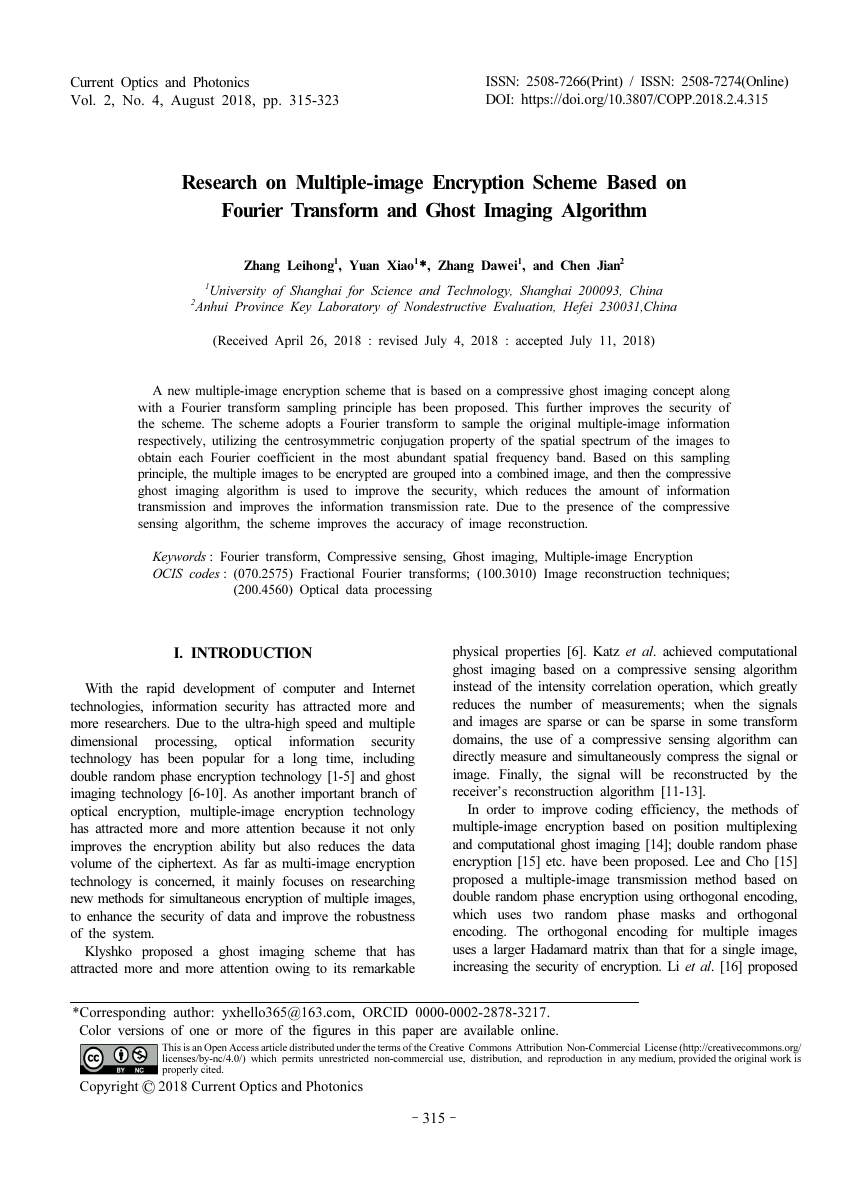
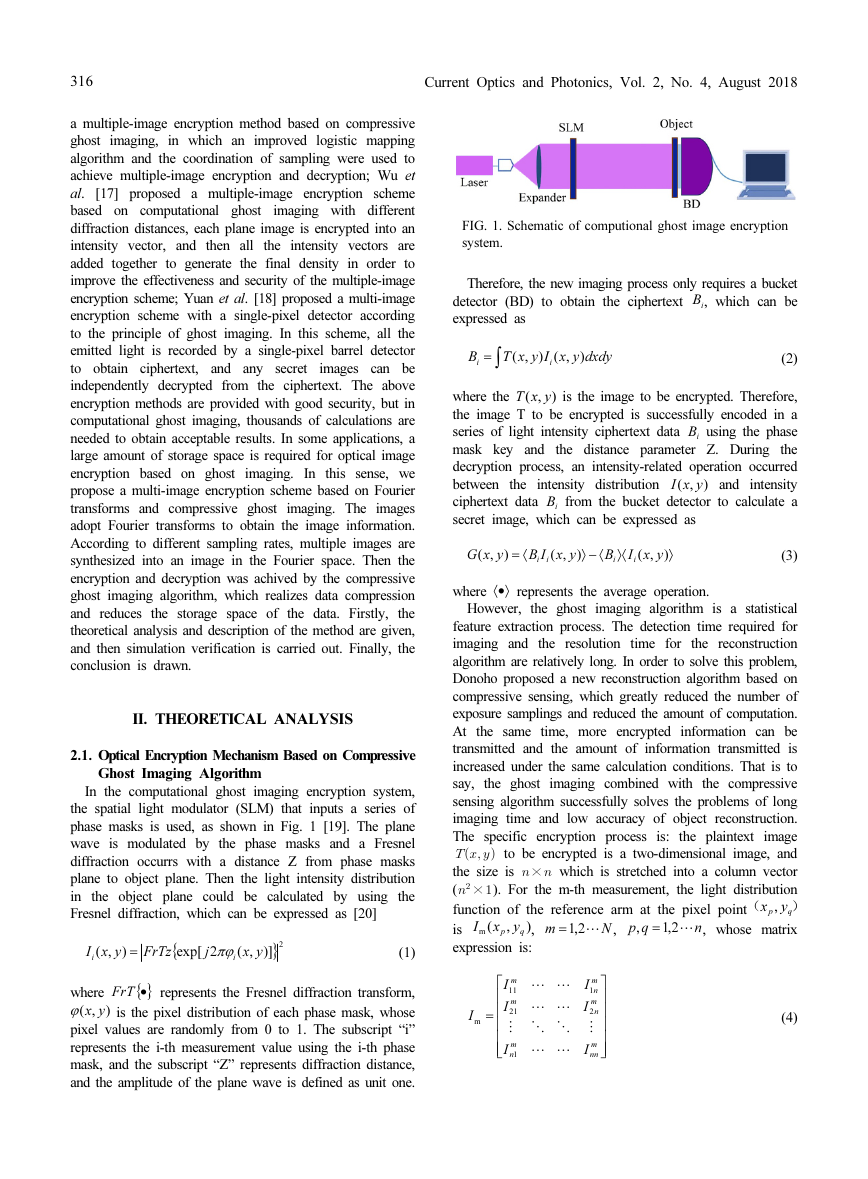
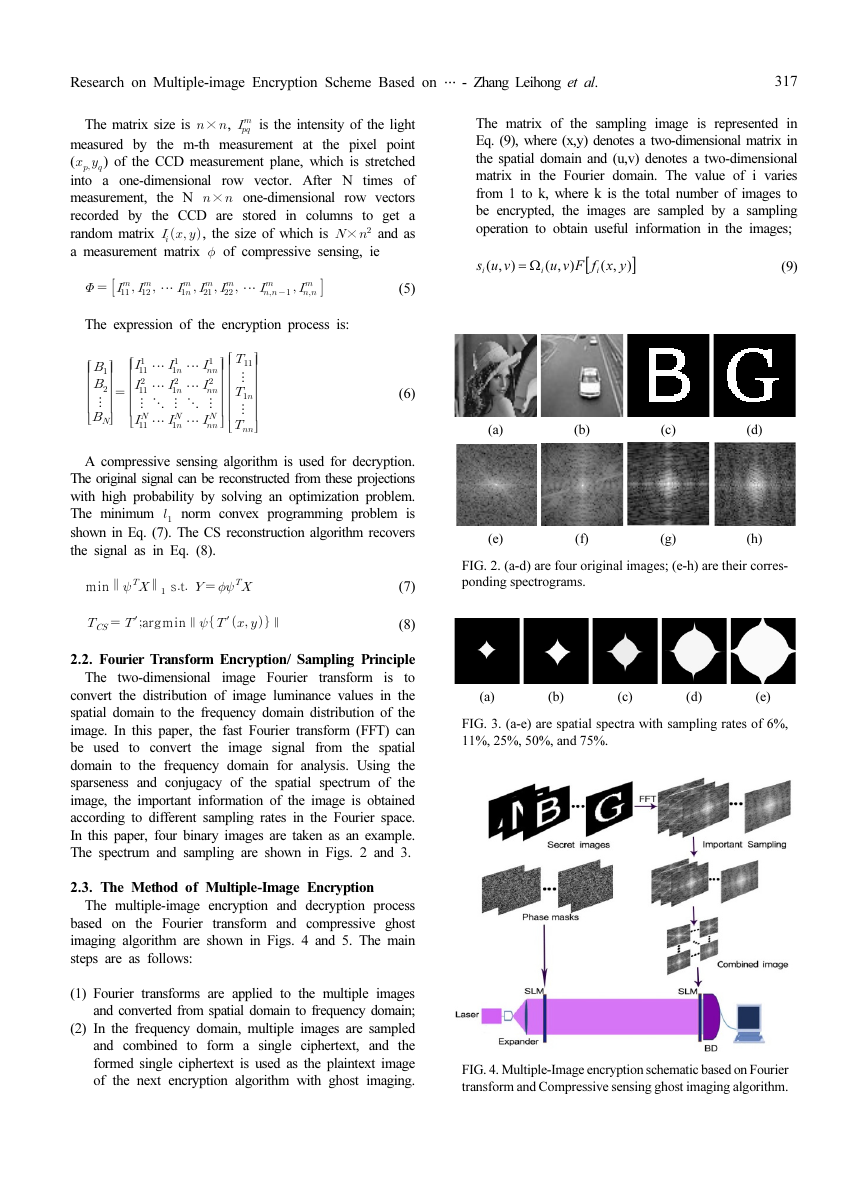
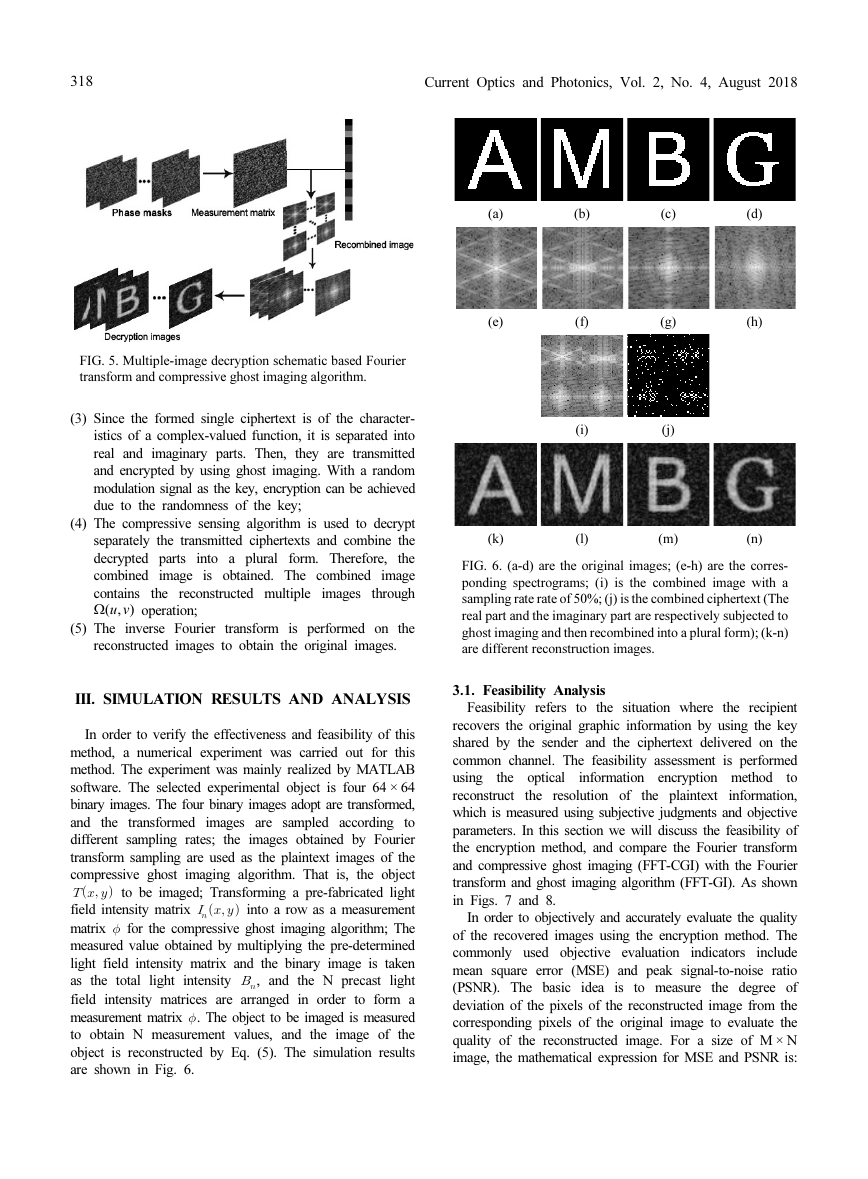

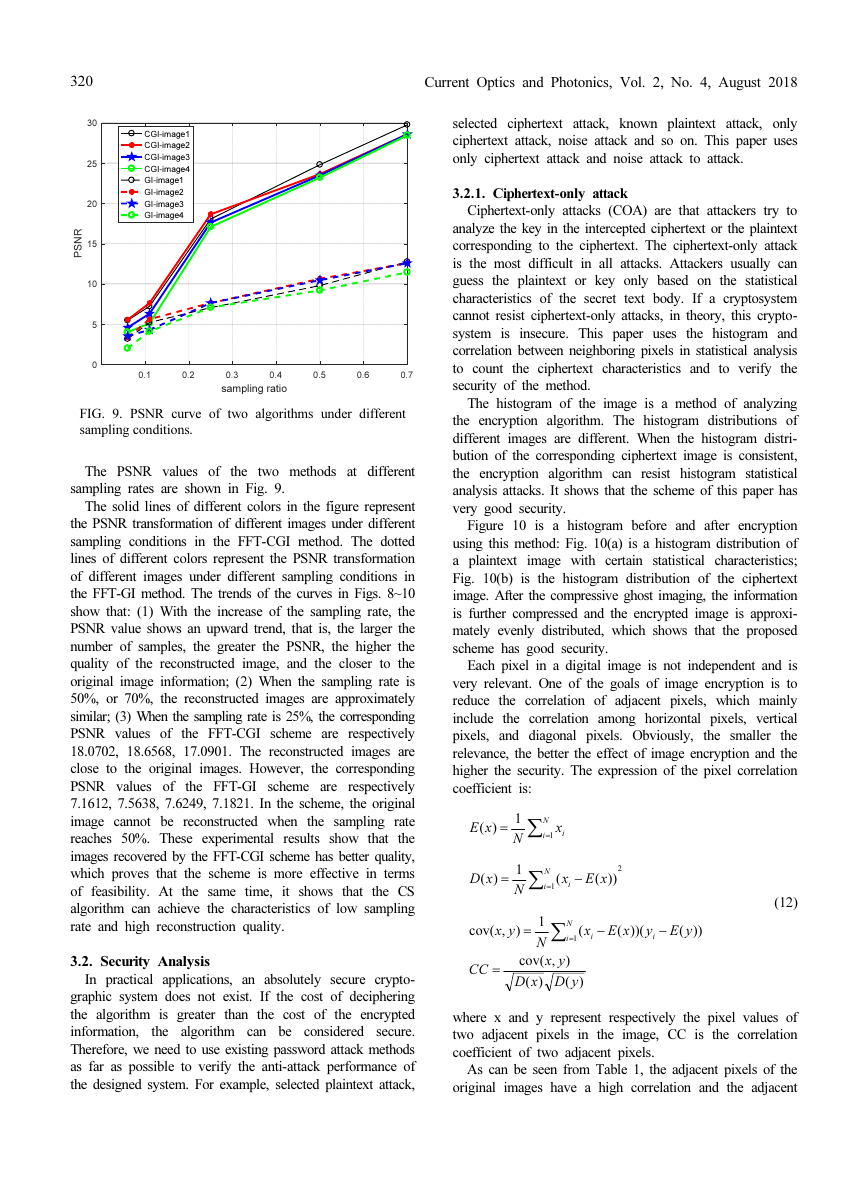

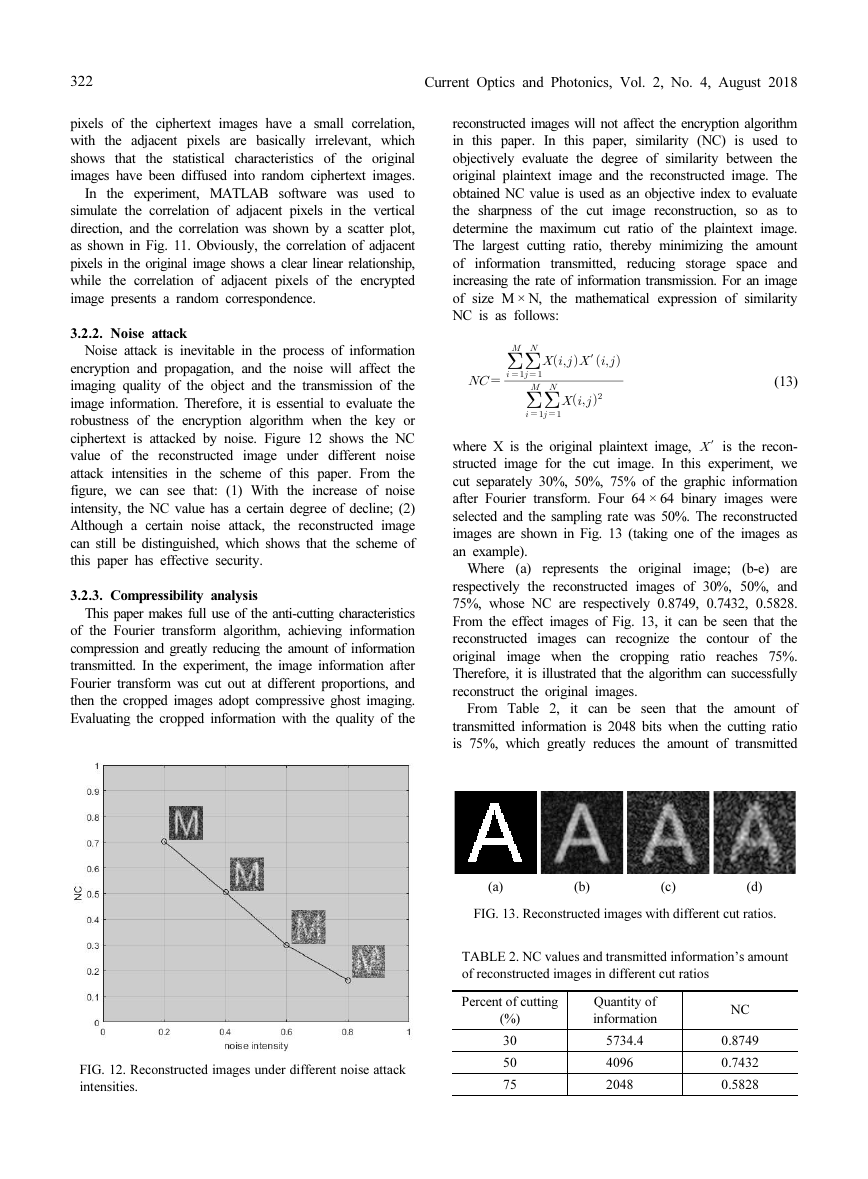








 2023年江西萍乡中考道德与法治真题及答案.doc
2023年江西萍乡中考道德与法治真题及答案.doc 2012年重庆南川中考生物真题及答案.doc
2012年重庆南川中考生物真题及答案.doc 2013年江西师范大学地理学综合及文艺理论基础考研真题.doc
2013年江西师范大学地理学综合及文艺理论基础考研真题.doc 2020年四川甘孜小升初语文真题及答案I卷.doc
2020年四川甘孜小升初语文真题及答案I卷.doc 2020年注册岩土工程师专业基础考试真题及答案.doc
2020年注册岩土工程师专业基础考试真题及答案.doc 2023-2024学年福建省厦门市九年级上学期数学月考试题及答案.doc
2023-2024学年福建省厦门市九年级上学期数学月考试题及答案.doc 2021-2022学年辽宁省沈阳市大东区九年级上学期语文期末试题及答案.doc
2021-2022学年辽宁省沈阳市大东区九年级上学期语文期末试题及答案.doc 2022-2023学年北京东城区初三第一学期物理期末试卷及答案.doc
2022-2023学年北京东城区初三第一学期物理期末试卷及答案.doc 2018上半年江西教师资格初中地理学科知识与教学能力真题及答案.doc
2018上半年江西教师资格初中地理学科知识与教学能力真题及答案.doc 2012年河北国家公务员申论考试真题及答案-省级.doc
2012年河北国家公务员申论考试真题及答案-省级.doc 2020-2021学年江苏省扬州市江都区邵樊片九年级上学期数学第一次质量检测试题及答案.doc
2020-2021学年江苏省扬州市江都区邵樊片九年级上学期数学第一次质量检测试题及答案.doc 2022下半年黑龙江教师资格证中学综合素质真题及答案.doc
2022下半年黑龙江教师资格证中学综合素质真题及答案.doc